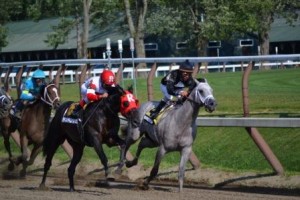Apr 30
2018
This article includes some trends about recent Kentucky Derby winners and other horses that have finished in the money for the Derby. Part of this discussion has to include the special challenge of distance for Derby contestants and related to that, the added challenge of horses facing a stretch run that is quite long at Churchill Downs.
As most people are aware, the Kentucky Derby is 1 1/4 mile (10 furlongs) long. A distance that no horse in the field has ever run prior to the Derby. That alone is challenge enough. In addition to that, many of the horses are coming from racetracks that have a stretch run considerably shorter than at Churchill Downs. The diagrams below shows the stretch runs for Gulfstream Park and Santa Anita Park. The length of the stretch runs are shown in feet beneath the blue arrows.
Read More >>
Aug 23
2015
Includes data through July 23, 2015 (with a recent update on a Bill Mott turnaround category).
A frequent question asked by new fans trying to learn more about horse racing is, “Where do I begin?” My immediate response is generally, “Get to know your trainers.” While learning about topics like distance, class, and pace are important … in my opinion, none are as important as learning about the tendencies, strengths, and weaknesses of trainers. With that thought in mind, last year we started a new series of articles called “Know Your Trainers.”
In this series we will dig into the statistics of some head trainers and try to make sense of the numbers we find. We thought it might be fun to present the numbers in a “competitive” manner by pairing trainers. With that said, we are not trying to judge the trainers or claim that one is better than another. Our intention is to pair trainers who have statistics in comparable categories and present some plausible reasons why they might differ.
Here is an update on two of the big names in the business, Todd Pletcher and Bill Mott. Our focus will be on two main areas; Graded Stakes and First Time Starters (FTS). The statistics presented were gathered with Daily Racing Form’s online software Formulator. We limited the data to the past two years, but you can go back five years if you want a larger sample of data.
Read More >>
Aug 10
2015
By Guest Author: Jim Mazur
Back in the good old days when I first started playing the horses (’72), this used to be an easy game to wager on. After handicapping the race, one simply went to the window and bet the selection to win, place or show. If a player really wanted to get exotic, then he or she could tie up two selections in a daily double.
Easy game. Can of corn. Now fast forward 43 years. The wagering menu has grown leaps and bounds both vertically and horizontally. From a vertical standpoint, there are now exactas, trifectas, superfectas and super5s. Horizontally, the game has evolved first into the Pick 3 and then wider into sequences demanding winners in 4, 5 6 and sometimes 9 consecutive races.
Read More >>
Jun 6
2015
In Part 1 of this article we showed a chart of the “disappointed dozen” horses who have attempted to win the Belmont Stakes after winning the Kentucky Derby and Preakness Stakes since 1978. Included in that article was a more detailed account of the first six of these Triple Crown candidates. In Part 2 we describe the attempts of the remaining six, and offer a comparison of all twelve with this year’s candidate, American Pharoah. We also contrast the Belmont Stakes spoilers from year’s past with the field from the 2015 Belmont Stakes.
Read More >>
Jun 2
2015
You know the story. Since the last Triple Crown winner in 1978, Affirmed, there have been 13 horses prior to American Pharoah, in a position to win the Triple Crown after they won the Kentucky Derby and Preakness Stakes. From this point forward, we are going to give a pass to one of these 13 horses, I’ll Have Another, who was scratched from the 2012 Belmont Stakes. How did the remaining twelve fair in the Belmont Stakes. Their record: ZERO wins, 4 seconds, 4 thirds … and 4 off the board. Given the fact all twelve were post-time favorites and their average win odds was 4-5, that’s not so good. It’s a pretty safe bet that American Pharoah will be somewhere around that 4-5 mark when they load the gate on June 6. Will he suffer the same fate of these dozen horses … highly regarded, heavily bet, and considered by many in the crowd to be destined for greatness?
In this article we’ll take a closer look at the disappointed dozen and see if we can find any common threads in their dashed dreams. Later (in Part 2) we’ll compare these past Triple Crown candidates with our present day candidate American Pharoah. Then you can decide for yourself whether or not he’s destined for greatness.
Read More >>
May 28
2015
Belmont Park is The Green Monster of Racetracks, with the largest oval of any thoroughbred racetrack in North America, 11/2 miles in circumference. That’s 12 furlongs, or put in relative terms, 3 furlongs longer than Saratoga and Aqueduct (the other two racetracks on the NYRA circuit). It’s 4 furlongs longer than Santa Anita, Churchill Downs, Monmouth Park, and other 1-mile tracks. Again, in relative terms, that 50% longer than those racetracks. Also, unlike many other racetracks, there are virtually no restrictions on the possible distances of races that can be run at Belmont.
Belmont is a visually stunning racetrack to witness in person. From the stands it seems like the backstretch is miles away. And, due to the structural design, there are no televisions mounted near the grandstand seats. For that reason, binoculars are as essential to the racing patron as a copy of the racing program and a cold draft beer. Fancy hats are optional.
Read More >>
Apr 28
2015
Since I will be offline for the majority of the Triple Crown races this year, I thought it would be nice to put together a collection of previously published articles that might be of some use to horseplayers and fans as they make their way through the 2015 Triple Crown season. Below is a list of the articles with a brief explanation why they might be of interest to you. Click on the Title to be transferred to the full article.
Read More >>
Apr 16
2015

Keeneland is a beautiful race course, set in the bucolic hills of Lexington, Kentucky. Each time we visit there we find something new. Unfortunately, we were unable to return there in the Spring of 2015, so the search for something new was limited to the internet … and sure enough, it was found. The Keeneland Handicapping Database.
Free to anyone with a computer and link to the internet, a database of 2,665 races run at Keeneland, from 2006 through the present. With one click, the information can be downloaded to a spreadsheet … and then sorted, sliced, and diced to your heart’s desire. And if you’ve been following this website for any length of time, you know that I can’t resist a little “Panning for Gold.” Below is a list of some of the data that’s available:
Read More >>
Apr 12
2015
In a prior article we introduced Claiming races. Click here for a review of that article. The type of races described in that article are open to any horse where the owner is willing to offer the horse for the claiming price of the race. But, there are other types of Claiming races where a horse can be entered only if they meet certain “conditions.” It is these type of races that we will focus on in this article. We’ll start with the simple, and work our way up to the more complex. Read More >>
Apr 5
2015

When handicapping, I will sometimes make the notation, “Needs The Lead” at the top of a horse’s Past Performances (PPs). Meaning they do their best (and sometimes only) running when they are happily cruising on an uncontested lead at the front of the pack.
Now, if the horse is running in a race on a speed favoring surface, or happens to be the “only” speed in the race, I will color code my comment in Blue (for a good thing). But, more times than not I don’t view this trait as a “good thing.” Especially if there are other “Needs The Lead” horses in the same race or if the horse in question doesn’t seem to have superior speed to establish an easy lead.
Read More >>


